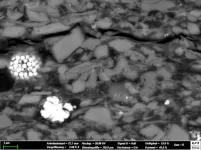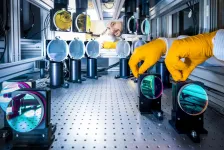(Press-News.org) The Alum Shale of Northern Europe not only has an eventful history of formation, connected with the microcontinent Baltica, it also holds great potential as an object of investigation for future research questions. Geologists use the rock to reconstruct processes of oil and gas formation, and even possible traces of past life on Mars can be identified with its help. Researchers at the German Research Centre for Geosciences Potsdam GFZ, together with colleagues from Canada, China, Switzerland and Denmark, have summarised the state of knowledge about the multi-layered rock. Their article was published in July in the journal Earth-Science Reviews.
The Microcontinent Baltica
"This rock tells a story," says Hans-Martin Schulz when he talks about the Northern European Alum Shale. It is the chequered history of a microcontinent called "Baltica", which was located in the southern hemisphere about 500 million years ago. "The microcontinent is surrounded by a calm, shallow marginal sea," says the scientist in the GFZ's Organic Geochemistry Section, describing the situation in the period from the Middle Cambrian to the Lower Ordovician. Higher land plants do not yet exist, and the surface of Baltica is exposed to wind and weather. "Rocks weather, and debris and dust are carried into the sea. Together with components of algae and other microorganisms, they trickle through the layers of the calm marginal sea and settle layer by layer in the oxygen-free bottom water," Schulz continues. These organic-mineral deposits fossilize and form the dark claystone that makes up today's Alum Shale. Over millions of years, Baltica migrated northwards and is now integrated into northern Europe. "Almost half a billion years later, the Baltic Sea forms on Baltica," Schulz concludes the first part of the story.
Oil and gas formation in phases
For three years, Schulz's group and international colleagues have been combing through their own data and that of other research groups. In their comprehensive synopsis, they also describe the different phases of oil and gas formation during Baltica's development. Parts of the microcontinent sink to depths of several thousand metres during migration. Oil forms under the influence of geothermal heat. "The oil that was generated at that time is now produced on the Swedish island of Gotland and in the Baltic Sea off the Polish coast," Schulz explains.
Other parts of the microcontinent occur more near the surface, for example in what is now southern Sweden. There, about 300 million years ago, increased expansion of the earth's crust takes place. Magma escapes, the heat of which causes further crude oil to form in the Alum Shale. "These rather regional deposits are enclosed in the rock," the geologist describes. At the end of the last ice age, about ten thousand years ago, sweet meltwater penetrates the shale here. "It meets tiny inclusions of ancient seawater. They contain bacteria that have survived for millions of years," Schulz describes. The fresh water awakens them to new activity, and further bacteria are possibly contained in the meltwater. The microbes decompose components of the oil and form methane gas.
Influence of Uranium
And that's not the end of the story: although there is still plenty of organic material, the oil-forming potential of the Alum Shale is declining. This is because it contains uranium, whose radiation alters the enclosed carbon compounds over long periods of time - "with fatal consequences for oil formation", as Schulz says. "The long chains are split off," he explains. "What remains are ring-shaped hydrocarbons, predominantly benzene rings, which are linked together." These changes prevent the further formation of petroleum from the organic remnants of Cambrian and Ordovician life. The uranium probably originated in the rocks that were eroded on Baltica and settled in the sea. "And seawater also contains dissolved uranium, so some of the radioactive metal could have been absorbed by the sediments from it," Schulz adds.
Alum Shale has many talents
The GFZ researcher and his team are investigating the significance of the very high uranium concentrations in places in the Alum Shale: "Can organic material altered by uranium still feed a deep biosphere?" they are asking themselves in ongoing studies, for example. Or does the radioactive fission of hydrocarbons prevent microbes from surviving at great depths? And it is not only the influence of uranium on microbial life that interests him. "The Alum Shale is a rock with many talents," Schulz says. "We can study numerous processes on it at different depths, at different degrees of maturity of the organic material, different uranium concentrations and sometimes extreme conditions."
The Alum Shale may even have answers to the question of past life at a distance of 70 million kilometres from Earth: organic components have been found on Mars that have structural similarities to those found in the Alum Shale. And similar to the uranium-containing terrestrial mudstone, these molecules were exposed to the equally radioactive cosmic over long periods of time. "So these hydrocarbon compounds could be the altered remains of organisms similar to our earlier bacteria," Schulz explains. "The Alum Shale serves as a Mars analogue for us to interpret the possible traces of past life on our neighbouring planet."
Insights into final disposal of nuclear waste?
For us on Earth, another aspect of his research is topical: besides salts and granites, mudstone is a candidate for the final disposal of nuclear waste. "We also have ideas for future projects on this," Schulz reveals. "At the core of this is the question of microbial life over long periods of time in the low-porosity, uranium-rich Alum Shale - but that story is on another page."
(Text: Dr. Ulrike Schneeweiß)
INFORMATION:
Astronomers using two of the world's most powerful radio telescopes have made a detailed and sensitive survey of a large segment of our home galaxy -- the Milky Way -- detecting previously unseen tracers of massive star formation, a process that dominates galactic ecosystems. The scientists combined the capabilities of the National Science Foundation's Karl G. Jansky Very Large Array (VLA) and the 100-meter Effelsberg Telescope in Germany to produce high-quality data that will serve researchers for years to come.
Stars with more than about ten times the mass of our Sun are important components of the Galaxy ...
Around 470 million years ago, plants began to conquer the terrestrial surfaces. The first examples had a small axis terminated by a structure capable of forming spores, almost like current mosses. The appearance of plant organs mediated the explosive radiation of land plants, which shaped the surface of our planet and allowed the establishment of terrestrial animal life.
However, evolving such a diversity of organs, such as roots, leaves, or immobile gametes, requires coordinated genetic changes: rise of new genes, repurpose of genetic material, and development of new regulatory programs. In a study published in Nature Plants, a consortium ...
A new study increases knowledge of the genetics behind aortic aneurysm, a disease that can spark life-threatening events like aortic dissections and ruptures.
University of Michigan Health-led researchers compared blood samples from more than 1,300 people who had a thoracic aortic aneurysm with more than 18,000 control samples, in partnership with U-M's Cardiovascular Health Improvement Project and its Michigan Genomics Initiative.
"After examining nearly the entire human genome for genetic changes that increase risk of aneurysm, we discovered a new change in the genetic code of a transcription factor, ...
Around 50,000 people suffer sudden cardiac arrest in Germany every year. When occurring outside a hospital, the chances of survival are only ten percent. Survivors often suffer from severe permanent neurological damage. On July 21st, 2021, researchers from the Faculty of Medicine - University of Freiburg, Germany, published together with German and US colleagues a review article in the journal Nature Reviews Neuroscience. They describe the most important therapeutic factors for successful resuscitation. The scientists name the therapy concept based on these factors ...
Key Takeaways
A survey of American College of Surgeons members found almost two-thirds treat firearm injuries and more than 85 percent support the organization advocating for policies to reduce firearm-related injuries.
Forty-two percent of ACS members keep firearms in their homes and nearly one-third (32 percent) of surgeon firearm owners store firearms unlocked and loaded.
Survey findings will enable the ACS to identify ways to engage all members, including gun owners, and advocate for initiatives that prevent firearm-related injuries.
CHICAGO (July 22, 2021): In what may be the largest survey of physician attitudes about firearms and how firearm-owning surgeons store guns in their homes, U.S. members of the American College of Surgeons ...
Scientists at Cambridge and Leeds have successfully reversed age-related memory loss in mice and say their discovery could lead to the development of treatments to prevent memory loss in people as they age.
In a study published today in Molecular Psychiatry, the team show that changes in the extracellular matrix of the brain - 'scaffolding' around nerve cells - lead to loss of memory with ageing, but that it is possible to reverse these using genetic treatments.
Recent evidence has emerged of the role of perineuronal nets (PNNs) in neuroplasticity - the ability of the brain to learn and adapt - and to make memories. ...
In the depths of space, there are celestial bodies where extreme conditions prevail: Rapidly rotating neutron stars generate super-strong magnetic fields. And black holes, with their enormous gravitational pull, can cause huge, energetic jets of matter to shoot out into space. An international physics team with the participation of the Helmholtz-Zentrum Dresden-Rossendorf (HZDR) has now proposed a new concept that could allow some of these extreme processes to be studied in the laboratory in the future: A special setup of two high-intensity laser beams could create conditions similar to those found near neutron stars. In ...
Over the last few decades, neurodegenerative diseases became one of the top 10 global causes of death. Researchers worldwide are making a strong effort to understand neurodegenerative diseases pathogenesis, which is essential to develop efficient treatments against these incurable diseases. However, our knowledge about the basic molecular mechanisms underlying the pathogenesis of neurodegenerative diseases is still lacking. A team of researchers found out the implication of lysosomes in the spread of Parkinson's disease.
The accumulation of misfolded protein aggregates in affected brain regions is a common hallmark shared by several neurodegenerative diseases (NDs). Mounting evidence in cellular and in animal models highlights the capability ...
Artificial intelligence tools and deep learning models are a powerful tool in cancer treatment. They can be used to analyze digital images of tumor biopsy samples, helping physicians quickly classify the type of cancer, predict prognosis and guide a course of treatment for the patient. However, unless these algorithms are properly calibrated, they can sometimes make inaccurate or biased predictions.
A new study led by researchers from the University of Chicago shows that deep learning models trained on large sets of cancer genetic and tissue histology data can easily identify the institution that submitted the images. The models, which use machine learning methods to "teach" themselves how to recognize certain cancer signatures, ...
Replication of SARS-CoV-2, the virus responsible for COVID-19, depends on a series of interactions between viral proteins and different cellular partners such as nucleic acids (DNA or RNA). Characterizing these interactions is crucial to elucidate the process of viral replication and identify new drugs for treating COVID-19.
An interdisciplinary consortium of scientists from the Institut Pasteur, the Ecole Polytechnique, the Institut Curie, Inserm, the CNRS and the universities of Paris, Paris-Saclay, Bordeaux and Toulouse have demonstrated a specific interaction between a domain of a SARS-CoV-2 protein (Nsp3) and ...


